| |
On Sunday, we took advantage of the fine fall weather to make an excursion on the Kitakami Line. This railroad crosses the central mountains of Japan, traveling between Kitakami and Yokote (in Akita Prefecture). Running along steep hillsides and across mountain valleys, it offers spectacular views — especially in autumn, when the leaves are changing. In Kitakami, some fall colors are starting to show, but as we ascended it became clear the leaves were much further along in the mountains. Exiting the first tunnel into a mountain valley, the change in view was so startling that everyone on the (somewhat crowded) train gasped. 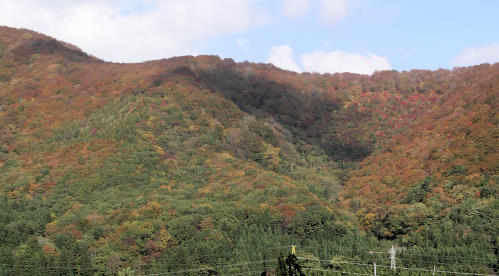 We were in and out of tunnels most of the way, with plenty of breathtaking scenery in between. Sometimes the colors were brightest on the hillside near the train. 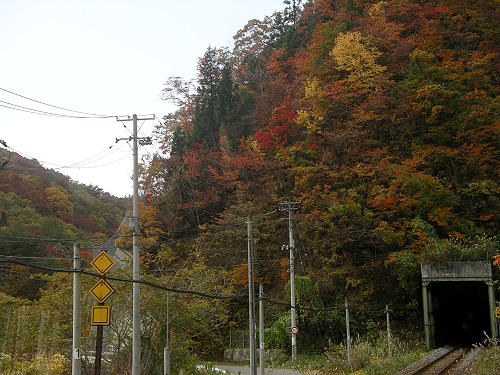 Other times, it was the view across a valley that was spectacular. 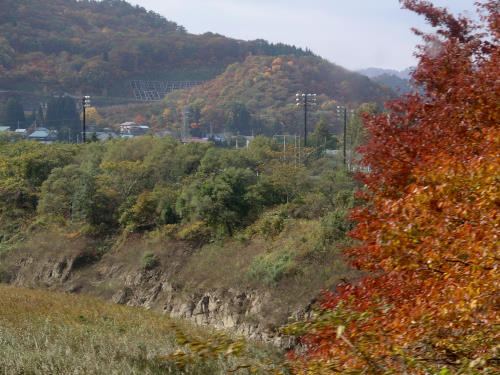 At the end of the line, we took a couple of hours to walk around Yokote. Brightly colored trees shared the view with Yokote Castle. 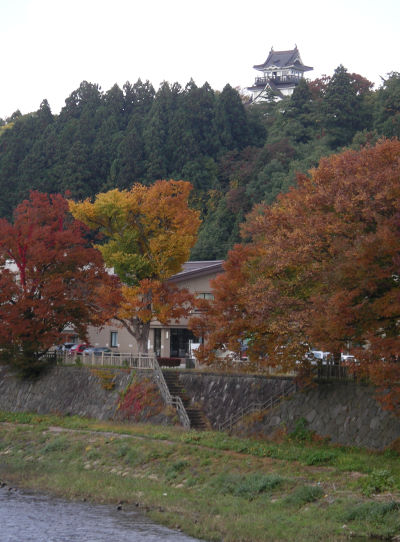 We left Yokote in the early afternoon so we'd have time to stop in Hotto Yuda, an onsen (hot spring) village along the way. There's even an onsen inside the railroad station! The town is on the shores of a mountain lake, in an area justly famous for the turning leaves. 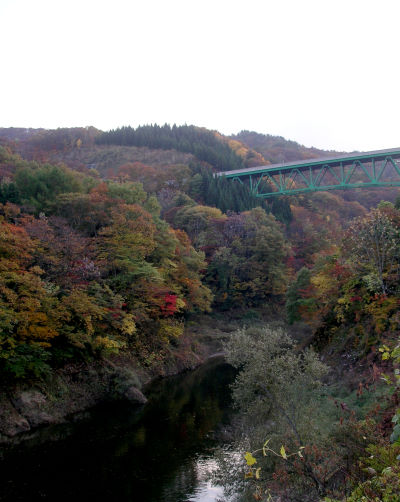 We enjoyed a soak in the spring (more on that later), then returned home, refreshed but exhausted.
Thursday, November 1, 2007, 3:17 AM FoodPosted by stefanie Fish ¡½ the most intimidating staple of the Japanese diet. We didn't cook fish much in America, but it's so easy to get cheap, high-quality fish here that it seems ridiculous not to. Not only can it be hard to cook well, it can be hard to know how to eat. Presented with a bite-sized cross-section of river fish last year, I ate the entire thing, including the spoo (read: innards), and felt wretched immediately. About two weeks later, I learned that some Japanese don't even eat the spoo because they don't like the taste. It's apparently like nattou in that respect.
Back to fish. Cooking fish in Japan frequently means butchering it yourself. Grocery stores sell river and smaller ocean fish whole. So if you're salt-grilling, you have the option of grilling the whole thing intact and eating around the spoo and bones. Or, you can de-gill and gut it; you would also have to do this if you're making sashimi or one of the simmered dishes. I've been practicing fish butchery intermittently over the past few months, and I think I've finally got it.
The first time I butchered a mackerel, the metallic smell that accompanies bloodletting kind of freaked me out (did I have a bad mackerel?). Also, I didn't do a particularly good job of filleting it; Matthew spent the better part of dinner working his way around bones. Now, decapitating, gutting, and filleting the fish all happen cleanly with just a few careful cuts and tugs on the appropriate fish parts. (I did get a bit careless in carrying the intestines over to the sink by one end, causing a large glop of spoo to drip out and land on the floor. It is worth noting that the dogs wouldn't go anywhere near the spoo either.) Last night's miso-simmered mackerel was a predominantly bone-free delight, and the dogs scored a bit of mackerel sashimi.
We haven't tried making sashimi at home yet, but hopefully, that day will come.
[ 4 comments ] permalink
Small Shrine Near the Station
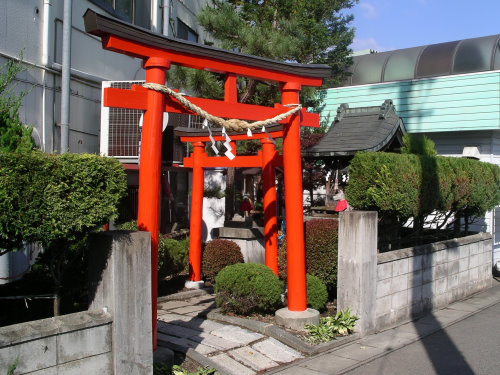 We've remarked before on the large number of small shrines that dot the cityscape. This one is near the station, next to a two-story bicycle parking garage.
Wednesday, October 31, 2007, 1:57 AM GeneralPosted by stefanie Public baths can be daunting to foreigners because of the language barrier and the unwritten etiquette. We visited plenty of public baths during our vacation last year, but I still get nervous about inadvertently breaking one of the rules. And my nascent language skills aren't quite up to the challenge of conversing about the finer points of public bathing. So our Sunday onsen (hot spring bath) visit left me feeling both extra clean and a bit confused.
We know the public bath drill. First, you wash your hair and body at a separate wall of spigots, using a large washcloth. After washing, you can soak as long as you like in the hot baths. Once you're done bathing, you shower off again before returning to the dressing room. It's all very civilized and quite enjoyable after you get past the "roomful of naked people" aspect.
I followed the drill: washing, soaking, contemplating. When I felt adequately onsened, I headed back to the spigots, but my spot near the soap was occupied. No matter. I figured I'd cool off with a soap-free rinse at another spigot. The woman next to me offered me some of soap she had brought. I told her that I was quite daijoubu, but thanks. And then she offered the soap again, with a kind (tolerant?) smile and a "kudasai."
Crap. "Kudasai" always makes me nervous because it's used for requests and I often don't know how to read the request. Did she mean "please, feel free to use my soap"? Or did she mean "No, seriously, it's completely unacceptable to not use soap after bathing. Don't you know the rules?" Not wanting to offend, I gave a very formal thank you and lathered up my oversized washcloth, desperately trying to remember whether I was supposed to use soap after soaking in the bath.
Next time, I'm taking my own soap.
[ 3 comments ] permalink
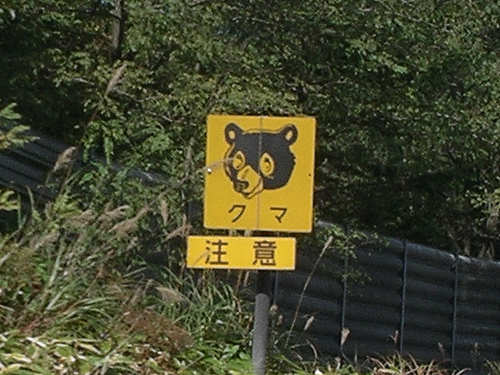 Beware of the bears. They're verrrry scary. No, really, they are. Grrr!
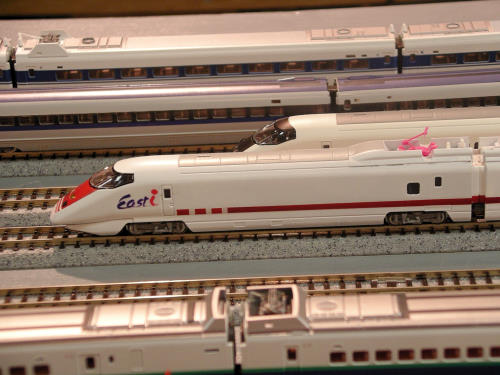 The "East-i" is JR East's shinkansen track inspection train. It runs at night, when regular passenger services do not run. There's no commercially made model of it, so a member of the Iwate Model Railroad Club ("Iwatetsu") made this one himself.
[ 4 comments ] permalink
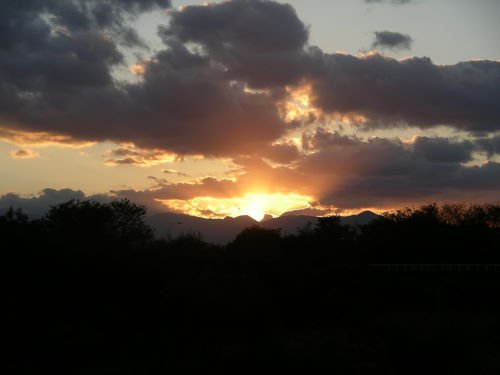 It's been a while since we've posted a sunset photo. The sunsets haven't gotten any less incredible.
Our neighbor across the street gave us a daikon (Japanese radish) from her garden tonight. 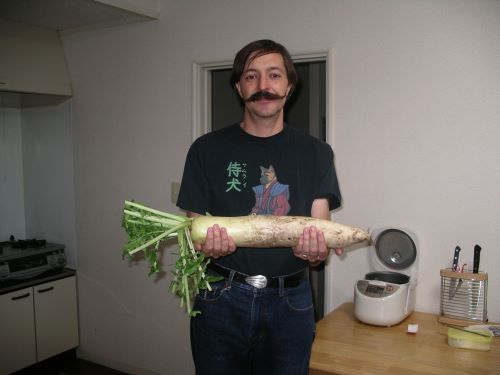 Guess I need to get pickling equipment sooner rather than later.
Something Old, Something New
Sunday, October 21, 2007, 8:22 PM GeneralPosted by stefanie On my way to Japanese class last week, I was stopped at a traffic light. An older woman, hunched over a kind of rolling walker thing, slowly crossed the street as cars waited. She wore the wide-brimmed hat, jacket, and knee-high rubber boots indicative of rice farmers; I presumed her bent posture was the result of years spent working in the paddies. When the light changed and traffic began to move, I caught a glimpse of accelerating white movement out of the corner of my eye. A Yamabiko shinkansen was leaving Kitakami Station, on its way north to Morioka. So it is in Tohoku, frequently described in tourist literature as one of the last remaining places to find "Old Japan." The past and the future collide on a daily basis here.
[ add comment ] permalink
Wednesday, October 17, 2007, 7:18 PM Strange JapanPosted by stefanie There seems to be a lot of road construction in and around Kitakami. Most times that I've been out driving around within the last few weeks, I've encountered lane shifts, diversions, or some other indicia of road work. Unlike Albuquerque, orange barrels don't appear to have much of a presence here.
My favorite construction phenomena, though, are the bowing flagmen. When a two-lane road is narrowed to one for a relatively short distance, a guy with one red and one green flag is stationed at either end of the site. Sometimes, there's even an advance team about 200 yards beforehand holding a sign asking you to slow down (at least, that's what I think it says). If you are the first car in the line that needs to stop, the flagman will wave his red flag at you, then bow when you have stopped. He will bow again before waving his green flag to let you pass through the construction zone. The courtesy makes it hard to be annoyed about any inconvenience. It's so civilized.
[ 2 comments ] permalink
Back Next
|
|















 Calendar
Calendar




